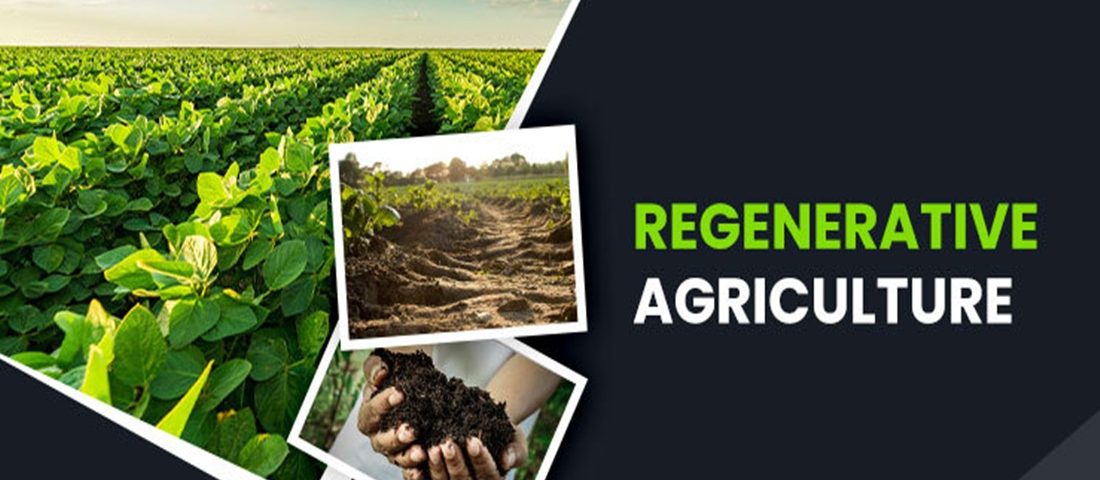- Have any questions?
- +880-1832219025
- englishrajib877@gmail.com
Regenerative Agriculture: Restoring the Earth

Unlocking TikTok SEO: Boost Your Reach with Effective Strategies
July 9, 2023
Mushroom Chocolate: A Blend of Flavors and Health Benefits
July 15, 2023Regenerative Agriculture: Restoring the Earth

Regenerative Agriculture– Regenerative agriculture is a transformative farming approach centered on working with nature to enhance ecosystem processes.

Goals of Regenerative Agriculture
- Implement practices that promote soil fertility, structure, and microbial diversity to revitalize degraded soils.
- Foster diverse ecosystems by reintroducing native plants, integrating cover crops, and supporting habitats for beneficial insects and wildlife.
- Utilize regenerative practices such as agroforestry and cover cropping to capture and store carbon in the soil, mitigating the impacts of climate change.
- Implement water-efficient techniques like rainwater harvesting, contour plowing, and reduced tillage to conserve water resources and improve water quality.
- Develop robust and adaptive agricultural systems that withstand environmental challenges, reducing reliance on external inputs and promoting long-term sustainability.
The Key Principles of Regenerative Agriculture
Soil Health: The Foundation of Regenerative Agriculture
Healthy soil is the cornerstone of regenerative agriculture.
It is teeming with diverse microorganisms, including bacteria, fungi, and earthworms, which contribute to its fertility and resilience.
Regenerative farmers prioritize soil health by minimizing tillage, using cover crops, and practicing crop rotation.
These techniques help enhance soil organic matter, improve water retention, and reduce erosion, leading to increased crop productivity and nutrient availability.
Biodiversity: Nurturing Nature’s Web of Life
Biodiversity plays a critical role in regenerative agriculture. By fostering a rich variety of plant and animal species, farmers can create dynamic and resilient ecosystems.
Planting diverse cover crops and incorporating hedgerows and windbreaks provide habitats for beneficial insects, birds, and pollinators.
This natural pest management approach reduces the need for chemical interventions, promoting ecological balance and reducing environmental impacts.
Water Management: Conserving Our Precious Resource
Water is a finite resource, and regenerative agriculture recognizes its significance.
By employing water conservation techniques such as mulching, contouring, and regenerative grazing, farmers can enhance water infiltration and reduce runoff.
These practices minimize soil erosion, improve drought resistance, and protect water quality, benefiting both agricultural systems and downstream ecosystems.

Carbon Sequestration: Combating Climate Change
Regenerative agriculture offers a powerful solution to combat climate change by sequestering carbon dioxide from the atmosphere.
Through practices like agroforestry, cover cropping, and rotational grazing, farmers can enhance carbon capture in soils and biomass.
This helps mitigate greenhouse gas emissions, enhance soil fertility, and contribute to a more stable climate.
Community Engagement: Fostering Resilient and Equitable Food Systems
Regenerative agriculture goes beyond ecological benefits; it also aims to create thriving communities.
By adopting regenerative practices, farmers can improve food security, foster local economies, and enhance the well-being of rural communities.
Direct-to-consumer marketing, community-supported agriculture (CSA), and farmer’s markets are some examples of initiatives that promote the connection between producers and consumers, creating a more equitable and resilient food system.
Regenerative Agriculture Practices
Regenerative agriculture practices prioritize ecological health and sustainability. These include cover cropping, crop rotation, minimal tillage, and holistic grazing.
By fostering biodiversity, improving soil health, and sequestering carbon, regenerative practices contribute to resilient ecosystems, reduced environmental impact, and increased agricultural sustainability.
Why is regenerative agriculture important?
Soil Health:
- Enhances soil fertility and structure.
- Mitigates erosion and improves water retention.
Climate Impact:
- Captures and sequesters carbon, mitigating climate change.
- Reduces greenhouse gas emissions.
Biodiversity:
- Promotes diverse ecosystems.
- Supports pollinators and wildlife.
Sustainability:
- Lowers dependence on synthetic inputs.
- Enhances long-term agricultural resilience.
Can regenerative agriculture reverse climate change?
Regenerative agriculture holds promise as a transformative approach to combat climate change. By prioritizing soil health, biodiversity, and carbon sequestration, this practice enhances ecosystem resilience and reduces greenhouse gas emissions. Through methods like cover cropping and holistic grazing, regenerative agriculture fosters carbon capture in the soil, potentially mitigating the effects of climate change. While not a panacea, widespread adoption of these principles may contribute significantly to building a more sustainable and resilient future.
Can Regenerative Agriculture Feed the World?
Regenerative agriculture presents a viable path to feeding the growing global population sustainably.
Studies indicate that adopting regenerative practices can enhance crop yields while preserving soil health.
According to the Rodale Institute, regenerative organic practices have the potential to increase yields by up to 40%.
By promoting resilience and reducing reliance on synthetic inputs, regenerative agriculture offers a promising solution to address food security challenges in the face of a changing climate.
What are the Benefits of Regenerative Agriculture for Farmers, the Environment, and Consumers?
Farmers:
- Improved soil health and fertility
- Increased crop yields and resilience
- Reduced reliance on synthetic inputs, lowering costs
Environment:
- Carbon sequestration mitigates climate change
- Enhanced biodiversity and ecosystem services
- Decreased water usage and minimized pollution
Consumers:
- Access to nutrient-rich, flavorful produce
- Supports sustainable and ethical farming practices
- Potential health benefits from improved soil and crop quality.
What is Needed to Accelerate the Transition to Regenerative Agriculture?
Education:
- Raise awareness about regenerative practices
- Provide training for farmers on implementation
Policy Support:
- Incentivize regenerative approaches
- Develop supportive agricultural policies
Research and Innovation:
- Invest in regenerative agriculture research
- Promote technological advancements
Market Demand:
- Encourage consumer preference for regeneratively grown products
- Foster partnerships to create market incentives.
Can Regenerative Agriculture Restore Lost Biodiversity?
Regenerative agriculture plays a pivotal role in restoring lost biodiversity. Studies reveal that adopting regenerative practices can significantly increase plant and animal diversity.
According to a 2021 research paper published in “Nature Reviews Earth & Environment,” regenerative approaches can enhance biodiversity by up to 44%, showcasing the potential of these methods to reverse the decline in species richness.
What is regenerated food?
Regenerated food refers to products cultivated through regenerative agricultural practices that prioritize soil health and sustainability. Examples include crops grown using cover cropping, rotational grazing for livestock, and agroforestry systems, promoting ecological balance and resilient ecosystems.
Future of Regenerative Agriculture
Increased Adoption: One of the key trends is the growing adoption of regenerative agriculture practices by farmers globally.
As awareness of the environmental impact of conventional farming practices increases, more farmers are likely to explore and transition to regenerative methods.
Technological Integration: The future of regenerative agriculture might involve increased integration of technology.
This could include precision agriculture technologies, data analytics, and remote sensing tools to optimize farming practices and monitor soil health.
Policy Support: Governments and agricultural organizations may play a crucial role in supporting regenerative agriculture through policies and incentives.
This could include subsidies, research funding, and regulatory frameworks that encourage sustainable farming practices.
Education and Outreach: As awareness grows, there might be an increased emphasis on educating farmers about regenerative agriculture practices.
Training programs, workshops, and outreach efforts could be expanded to help farmers implement these methods effectively.
Market Demand for Sustainable Products: Consumer demand for sustainably produced food is likely to increase.
As a result, more food companies and retailers may incentivize regenerative practices in their supply chains to meet consumer expectations and enhance their sustainability credentials.
Research and Innovation: Ongoing research into regenerative agriculture will likely lead to the development of new techniques, crop varieties, and management practices.
This continuous innovation can further enhance the feasibility and effectiveness of regenerative agriculture on a larger scale.
Collaboration and Networking: Farmers, researchers, policymakers, and environmental organizations may collaborate more closely to share knowledge, resources, and best practices.
This collaborative approach can facilitate the widespread adoption of regenerative agriculture.
Climate Resilience: Regenerative agriculture is often promoted as a strategy for building resilience to climate change.
The future of regenerative agriculture may involve a heightened focus on its role in mitigating the impacts of climate change on food production.
It’s important to note that the future of regenerative agriculture depends on a complex interplay of factors, including technological developments, policy decisions, market dynamics, and the commitment of stakeholders across the agricultural value chain.
Frequently Asked Questions (FAQs)
Q: What is regenerative organic agriculture?
Regenerative organic agriculture is an ecological farming approach that prioritizes soil health, biodiversity, and holistic land management. It integrates organic principles with regenerative practices, emphasizing soil regeneration, carbon sequestration, and ecosystem resilience. This approach seeks to create a sustainable and symbiotic relationship between agriculture and the environment.
Q: What is the difference between carbon farming and regenerative agriculture?
Carbon farming focuses on carbon sequestration, often through specific practices, while regenerative agriculture is a holistic approach emphasizing overall ecosystem health.
Q: What is the difference between regenerative agriculture and organic farming?
Regenerative agriculture and organic farming share common goals of sustainable and environmentally friendly practices.
However, regenerative agriculture goes a step further by focusing on soil health and ecosystem restoration.
While organic farming emphasizes the avoidance of synthetic inputs and genetically modified organisms, regenerative agriculture emphasizes building soil organic matter, biodiversity, and carbon sequestration.
Q: What is the meaning of Regenagri?
Regenagri likely refers to the combination of “regenerative” and “agriculture,” representing practices that prioritize ecological health and sustainability in farming.
Q: What is regenerative organic agriculture?
Regenerative organic agriculture integrates organic principles with regenerative practices, prioritizing soil health, biodiversity, and holistic land management for sustainability.
Q: What is the difference between carbon farming and regenerative agriculture?
Carbon farming emphasizes carbon sequestration, while regenerative agriculture is a holistic approach fostering overall ecological health, soil regeneration, and sustainability.
Q: Can regenerative agriculture be applied to all types of farming?
Yes, regenerative agriculture principles can be applied to various farming systems, including crop production, livestock farming, and agroforestry.
The principles are adaptable and can be tailored to suit different geographical locations, soil types, and farming scales.
By understanding the local ecosystem and implementing suitable regenerative practices, farmers can transition towards more sustainable and resilient agricultural systems.
Q: Does regenerative agriculture increase farm profitability?
Regenerative agriculture can indeed lead to increased farm profitability in the long run.
By improving soil health and fertility, farmers can achieve higher crop yields and reduce the need for synthetic inputs.
Additionally, regenerative practices can reduce production costs associated with chemical fertilizers, pesticides, and water usage.
Moreover, regenerative agriculture enhances the market value of products by meeting the growing consumer demand for sustainably produced food.
Q: Is regenerative agriculture scientifically proven?
Yes, regenerative agriculture is backed by scientific research and has gained recognition from experts in the field of agriculture and ecology.
Numerous studies have demonstrated the positive impacts of regenerative practices on soil health, biodiversity, and climate change mitigation.
The science behind regenerative agriculture continues to evolve, with ongoing research providing further insights and validation of its effectiveness.
Q: Are there any government programs or incentives for regenerative agriculture?
Many governments and organizations around the world have recognized the potential of regenerative agriculture and offer various programs and incentives to support its adoption.
These initiatives may include grants,cost-sharing programs, tax incentives, and technical assistance.
Farmers and landowners are interested in transitioning to regenerative practices should explore local, regional, and national resources to access the available support.
Q: How can consumers support regenerative agriculture?
Consumers play a crucial role in promoting regenerative agriculture.
By making informed choices and supporting farmers and food producers who follow regenerative practices, consumers can drive the demand for sustainably produced food.
Purchasing from local farmer’s markets, joining community-supported agriculture (CSA) programs, and seeking out certifications like”Regenerative Organic Certified” can all contribute to the growth of regenerative agriculture.
How to Live a Sustainable Lifestyle
Impacts of Sustainable Living on Society
Education and Sustainable Development
Mushroom Chocolate: A Delightful Blend of Flavors and Health Benefits
10 Foods That Are Toxic for Dogs and Should Be Avoided at All Costs






19 Comments
Very important post
Thanks a lot!
Thanks for sharing
Dear Sagor,
You are welcome!
Help full content
Dear Faruk,
Thank you so much!
Your explanation is very nice
Dear Faruk,
Thank you so much for your appreciation!
Very useful blog
Hello Fatiha,
Thank you so much!
Good news for financial Deployment……
Dear BD H Plan,
You are welcome!
Helpful post
Hello Rifat,
Thank you so much for your appreciation!
Help full content
Thank you so much!
Good post
Dear Asif,
You are welcome.
I love this website � It has exciting contents with interesting topics.♥️♥️♥️♥️♥️